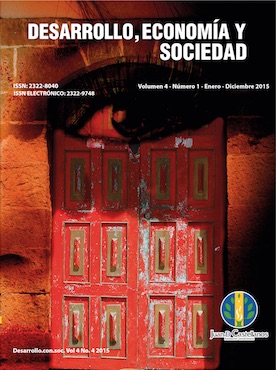Keywords:
Argentina, Chile, Channel, Arrangement of disputes.Abstract
This article intends to give an explanation of the events that favored the signing of the Treaty of Peace and Friendship between Argentina and Chile according the theory of conflict transformation, from the perspective given by the subdisciplinar field of Latin American history of international relations. To do this, we have divided this article into the following parts: first, we will make a historical tour about the genesis and evolution of the Beagle conflict throughout the twentieth century, including the arbitration of His Majesty, the rejection of the award by the Militrary Government of Argentina and the subsequent mediation of His Holiness Pope John Paul II. Second, we develop the main existing issues in the Treaty of 1984, as was a catalyst for the renewal of international relations between the two countries and the beginning of a process of integration and friendship can be understood in the light of the Kantian culture. Third, we introduce you to some explanatory notions of the theory of conflict transformation and present an overview of the most important events and developments of bilateral relations between Argentina and Chile we frame in that theory. Finally, we will present our preliminary conclusions in order to foster the debate and scientific exchange on this issue.
Downloads
References
Arredondo, R. (1996). Acerca del Acuerdo de los presidentes Menem y Aylwin del 2 de agosto de 1991, que establece un Nuevo límite internacional en los hielos continentales patagónicos. Academia Nacional de Geografía, 11, 51-53.
Bruculo, C. (2014). Aproximación y balance en materia de cooperación e integración entre Argentina y Chile desde vínculos subnacionales: Comités de Integración. A 30 años del Tratado de Paz y Amistad. Ponencia llevada a cabo en el XI Congreso Nacional y IV Congreso Internacional sobre Democracia, Rosario, Argentina.
Catalán Cruz, L. H. (2005). La Dinámica del conflicto en las relaciones internacionales contemporáneas. Instituto de Relaciones Internacionales, (2), 109-128. Recuperado de http://revistamarina.cl/revistas/2005/2/catalan.pdf
Corporación de Defensa de la Soberanía. (2010). Historia de las Controversias Históricas entre Chile y Argentina. Chile. Recuperado de http://www.soberaniachile.cl
Eissa, S. (2014). Hielos continentales: la política exterior argentina en los ’90. Centro Argentino de Estudios Internacionales. Recuperado en: http://www.caei.com.ar/sites/default/files/ebook45.pdf
Escudé, C., y Cisneros, A. (2000). Historia General de las Relaciones Exteriores de la Argentina. Tomo I: Las relaciones exteriores de la Argentina embrionaria 1803- 1881 y Tomo VII: La Argentina frente a la América del Sur 1881-1930. Buenos Aires, Argentina: Grupo Editor Latinoamericano. Recuperado de www.argentina-rree.com
Freund, J. (1987). Sociología del conflicto. Buenos Aires: Editorial Fundación CERIEN.
Lacoste, P. (2005). El conflicto del Beagle. Todo es historia, (461), 68-76.
Lanús, J. A. (1984). De Chapultepec al Beagle. Política exterior argentina: 1945 – 1980. Buenos Aires: Emecé Editores.
Lederach, J. P. (2009). The Litlle Book of Conflict Transformation. University of Colorado: Good Books. Recuperado de http://www.beyondintractability.org/essay/transformation/?nid=1223
Lorenzini, M. E. (2009). La relación argentino- chilena 1999-2007 ¿Alianza estratégica o profundización del vínculo bilateral? Análisis desde el enfoque de las macro y micro-relaciones. (Tesis de doctorado inédita). Universidad Nacional de Rosario, Rosario, Argentina.
Melo, A. L. (1979). La cuestión internacional del Canal de Beagle. Buenos Aires: Ediciones De Palma.
Melo, A. L. y Strubbia, M. (1981). La mediación papal y el conflicto austral. Buenos Aires: Ediciones De Palma.
Meza Monge, N. (2012). Espacios Regionales fronterizos. Escenarios de integración. Integración & Comercio, 34(16), 25-32.
Novaro, M. y Palermo, V. (2003). Historia Argentina 9. La dictadura military 1976/1983. Del golpe de Estado a la restauración democrática. Buenos Aires, Argentina: Paidós.
Miall, H., Ramsbotham, O., & Woodhouse, T. (1999). Contemporary conflict resolution. The prevention, management and transformation of deadly conflicts. Cambridge, United Kingdom: Polity Press.
Reimann, C. (2001). Towards Conflict Transformation: Assessing the State-of-the- Art in Conflict Management – Reflections from a Theoretical Perspective. Germany: Berghof Handbook for Conflict Transformation.
Rojas Aravena, F. (2001). La construcción de una alianza estratégica el caso de Chile y Argentina. Inter-American Dialogue. Ponencia llevada a cabo en el Seminario Internacional Conflictos Fronterizos en América Latina, Washington, D.C.
SELA. (2013). Cooperación Regional en el ámbito de la Integración Fronteriza. XXIV Reunión de Directores de Cooperación Internacional de América Latina y el Caribe. N° 2.
Valenciano, E. (1990). Los Comités de fronteras: funcionamiento y experiencia. Buenos Aires: INTAL.
Villaverde, A. (2010). El sistema UNSAS y la Fuerza de Paz Combinada Cruz del Sur. Peace Operations Training Institute. Recuperado de http://cdn.peaceopstraining.org/theses/villaverde.pdf
Wendt, A. (1999). Social Theory of International Politics. United Kingdom: Cambridge University Press.
Woodhouse, T. (1999). International Conflict Resolution: some critiques and a response. Department of Peace Studies, University of Bradford: Centre for Conflict Resolution.





